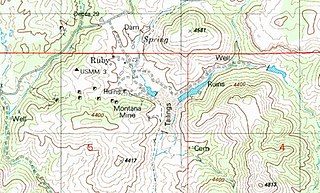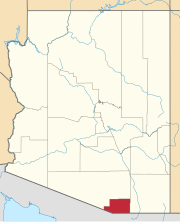Ruby, Arizona
Ruby, Arizona | |
|---|---|
DST )) | |
| Post office opened: | April 11, 1912 |
| Post office closed: | May 31, 1941 |
Ruby is a
History



Mining started circa 1877. The Montana Mine produced gold, silver, lead, zinc and copper. At its peak in the mid-1930s, Ruby had a population of about 1,200.[2]
On April 11, 1912 the mining camp's general store owner Julius Andrews established the post office. Andrews named the post office "Ruby", after his wife, Lille B. Ruby Andrews, and the mining camp soon became known as Ruby. The post office was discontinued on May 31, 1941.[3]
Between 1920 and 1922, the town of Ruby and the surroundings were the scene of three double homicides known as the
The most prosperous period for Ruby was in the late 1920s and 1930s, when the
Ruby is one of the two best-preserved mining ghost towns in Arizona, along with the Vulture Mine near Wickenburg. Ruby's attractions today include approximately 25 buildings under roof, including the jail and houses, the school, the playground, mine machinery, buildings and mine workings. Ruby is entirely on private property and there is a charge for admission to the site.[2]
Public tours are occasionally offered through Pima Community College.[6]
See also
- Bear Valley Raid
- Battle of Bear Valley
- List of ghost towns in Arizona
References
- ^ U.S. Geological Survey Geographic Names Information System: Ruby
- ^ ISBN 0-916179-44-3
- ISBN 0-8165-0009-6
- ^ "Ruby, Arizona - A Ghost Town Filled With Mining and Murder". Legends of America.
- ISBN 0-8061-0843-6.
- ^ Pima College ST-210
Further reading
- Ring, Al, et al.(2005) Ruby, Arizona: Mining, Mayhem, and Murder. Tucson: U.S. Press and Graphics, 2005.
- Dolan, Samuel K. Cowboys and Gangsters: Stories of an Untamed Southwest (TwoDot Books, 2016) ISBN 9781442246690
External links
- Historic Ghost Town of Ruby, AZ
- Mining and Murder in Ruby, Arizona
- Ruby at GhostTowns.com
- Ruby – Ghost Town of the Month at azghosttowns.com

